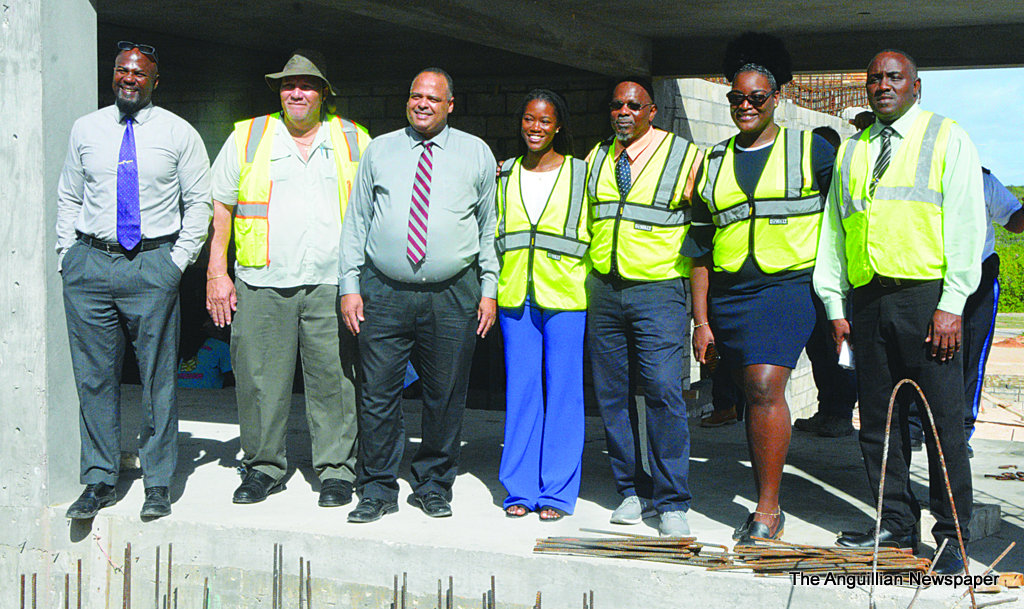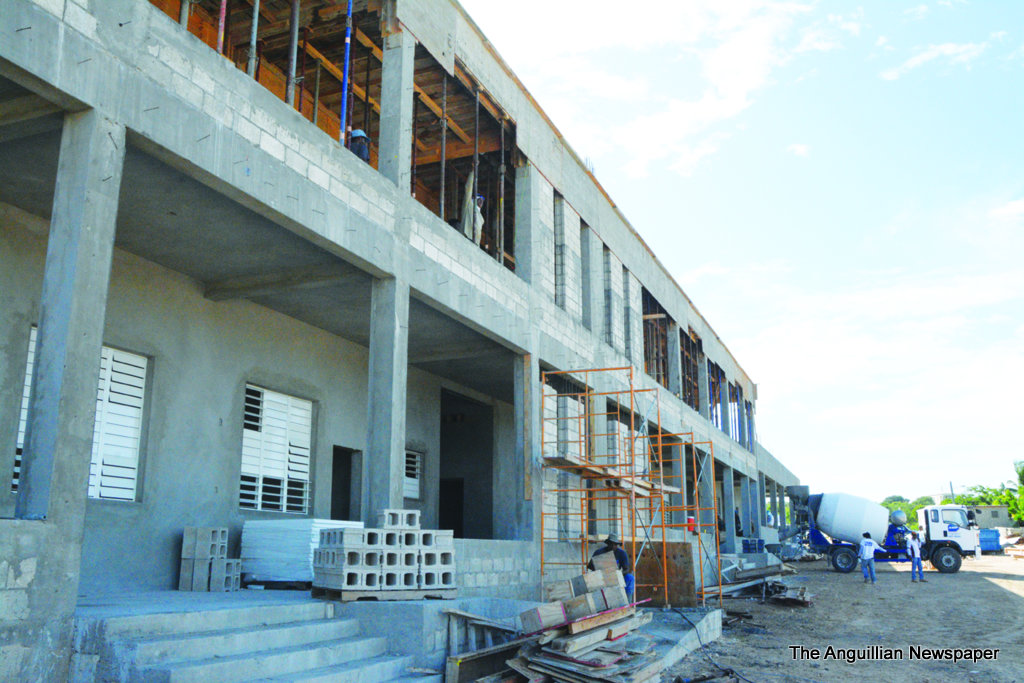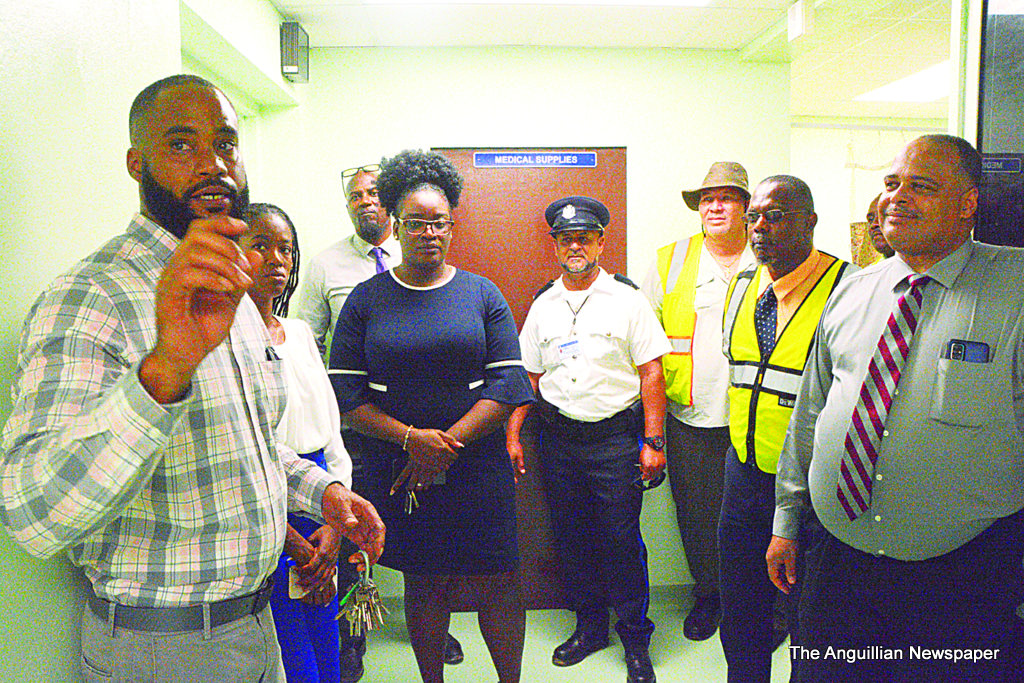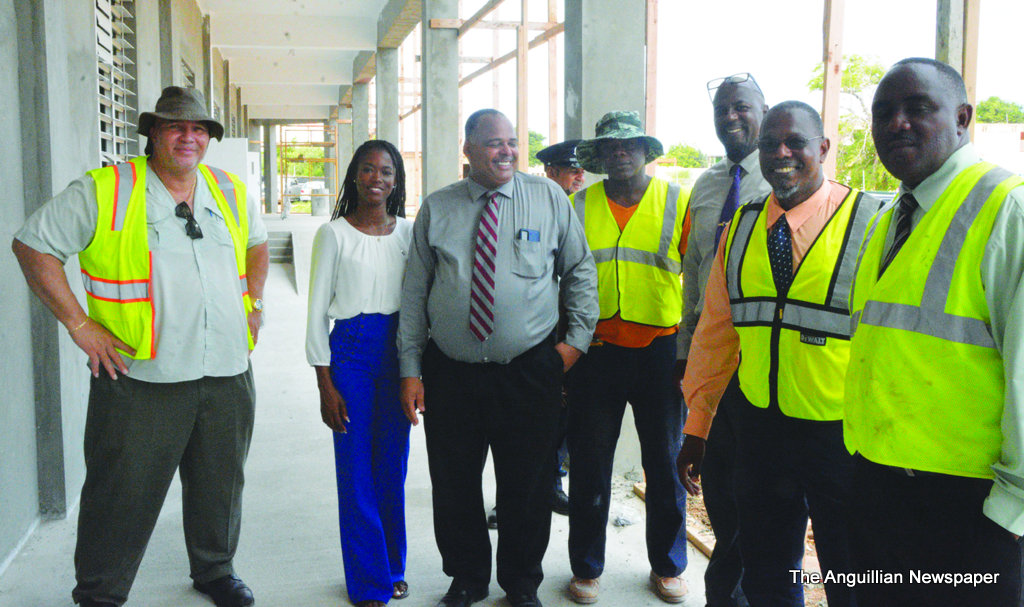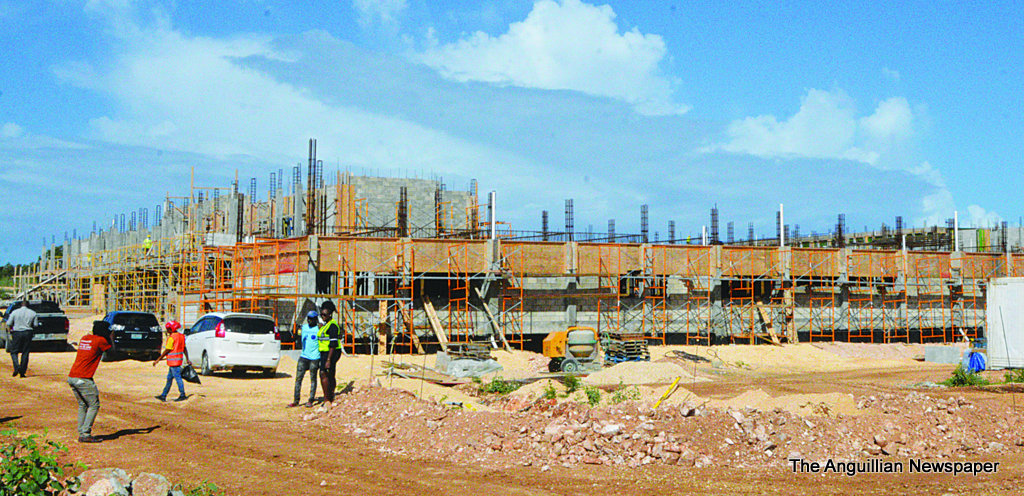
The Premier, Dr. Ellis Webster, Ministers, Parliamentary Secretary and Special Ministerial Assistants, are now fully cognizant about the status of eight of the public sector projects funded, under the sixty million pounds Anguilla Programme, by the United Kingdom Government. The projects include the rebuilding and refurbishing of schools and health facilities which were severely damaged by Hurricane Irma in September 2017.
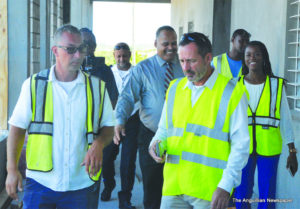
The Government toured the projects for some four hours from 9.00 am to about 1.00 pm on Tuesday, October 27, to get an update on the construction work and to meet the Anguillian contractors and their workmen. The tour was led by Mr. Darren Forbes-Batey, MBE, Manager of the Anguilla Programme in the Governor’s Office.
Speaking at the site of the completely new Morris Vanterpool Primary School, where the tour began, Mr. Forbes-Batey told The Anguillian newspaper that around forty to fifty million US dollars was budgeted for the Primary Schools and the Albena Lake-Hodge Comprehensive School, amounting to about fifty percent of the Anguilla Programme budget. He said that while those projects took up the biggest portion of the sixty million pounds, “education is important and it was decided that this would be the prime focus of the programme – along with healthcare and other infrastructure.”
The work on the new Morris Vanterpool School was somewhat delayed, according to Mr. Velroy Vanterpool, the project supervisor. This was due to the discovery of two caves which had to be excavated, compacted and heavily overlaid with concrete to accommodate the science lab and the multi-media room. The school is in two structures: the two-storey building to the east for classrooms, with each being 25×25 square feet; and the mass multi-purpose building to the west for administrative offices, library, auditorium, cafeteria, technical facilities and other services.
The next tour was of the Albena Lake-Hodge Comprehensive School in The Quarter. The Minister of Education, Ms. Dee-Ann Kentish-Rogers, speaking from a design plan for the school, indicated that although the project accounted for some 26 million US dollars, and appeared to be very large, there was a need for more funding for additional classrooms. These include the TVET and Agricultural block costing in excess of four million US dollars
and an assembly hall. The Minister went on: “There are significant challenges to this development, but we are doing the best we can, given the financial constraints. This [the first three blocks of the school], is phase one of the project. Phase two is supposed to include the PRU (Pupils Referral Unit), the D.O.V.E. Centre (Developing Our Vision for Education) and WISE (Workshop Initiative for Special Education) which are currently being operated off campus [in rented accommodation]. Phase 3 is supposed to accommodate a lower school, but all of those require extra funding of about 12.5 million US dollars. This [the project as it is], is not going to solve the shift system.”
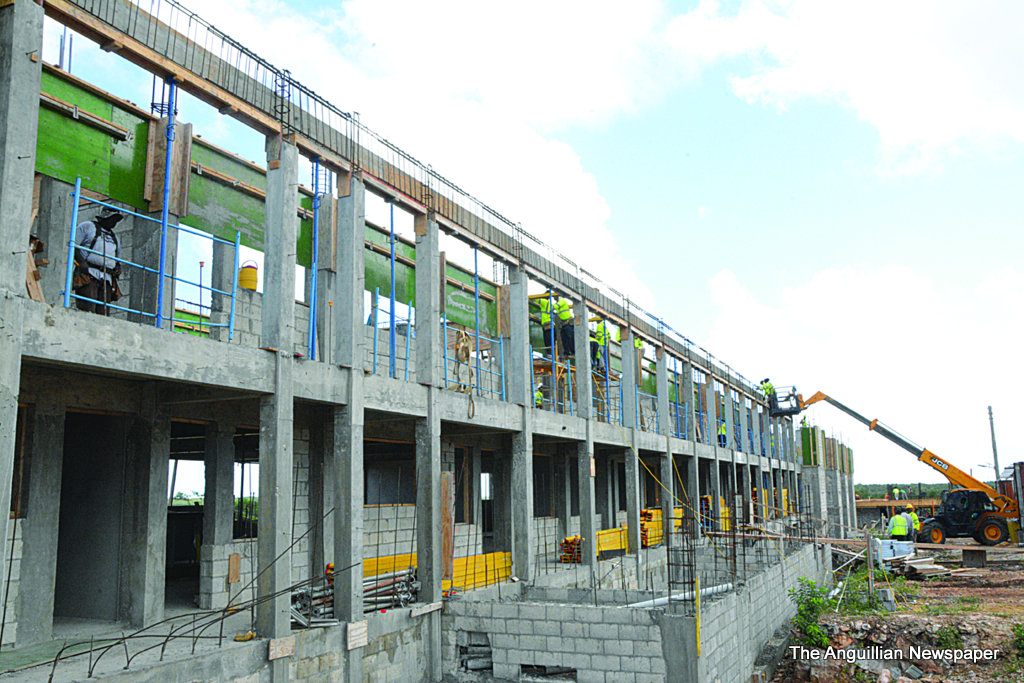
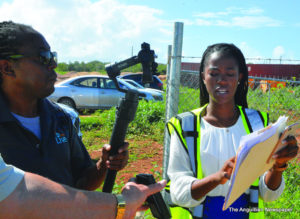
The statement that the new ALHCS project, as it currently is, would not solve the current shift system at the existing school buildings in The Valley, unless more classroom space was available at the new site, is considered to be disappointing as it was expected that the end of the shift system was in sight. Another matter at the project site is that the planned athletic track on the 17.5 acre lot can no longer be built at the site due to the remaining solid rock-bound area. It is therefore being considered that the planned athletic track in the flat Long Pond area is a good alternative. A third matter of concern is the belief that some portions of the new school project are below ground level and are therefore prone to flooding. This view was expressed in particular by the Minister of Infrastructure, Mr. Haydn Hughes, while expressing gratitude for the Anguilla Programme funding.
The third tour was to the Orealia Kelly Primary School where the two-storey eight-classroom block is almost completed. Each classroom measures 30×30 square-feet. Work is now in progress on the auditorium at the eastern end of the existing school building.
The tour continued at the Princess Alexandra Hospital which has been significantly upgraded by the Anguilla Programme grant – and other British Government funds. The improvements include Covid-19 testing and isolation facilities; new adults’ and children’s wards; an extended laboratory; an oxygen plant; an electricity-generating plant; and a multi-purpose storage facility including a new morgue, space for medical and other supplies and, on a top floor, accommodation for Emergency Medical Technicians. At present, work is in progress to provide an extra sewage underground system to compensate for the pressure placed on the original system by the laboratory expansion.
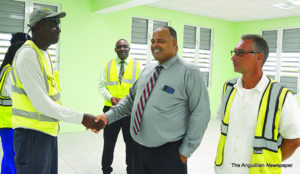
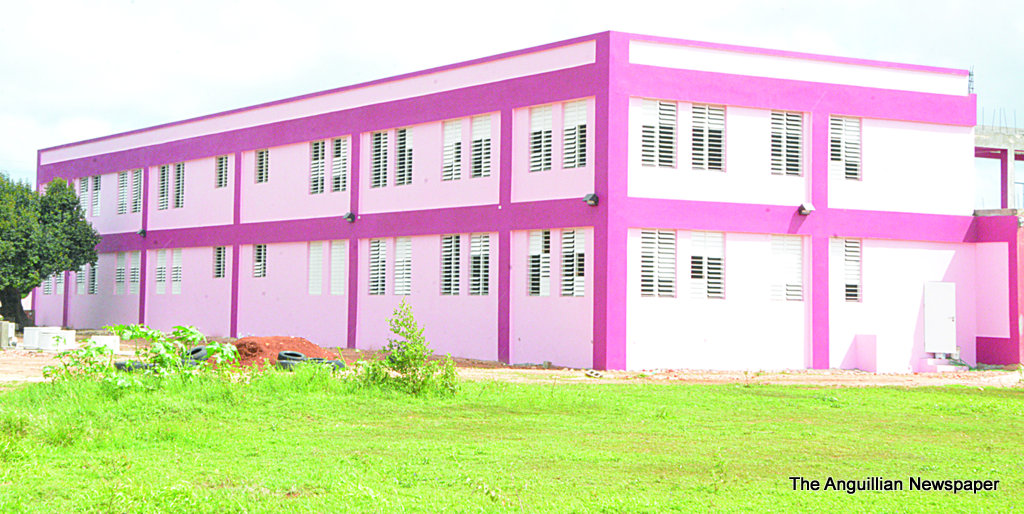 The new Valley Polyclinic was the next project toured. This imposing edifice, in the centre of Anguilla, will accommodate the pharmacy from the hospital; administrative offices for Health Authority personnel; a Board Room; and a dental clinic, among other facilities.
The new Valley Polyclinic was the next project toured. This imposing edifice, in the centre of Anguilla, will accommodate the pharmacy from the hospital; administrative offices for Health Authority personnel; a Board Room; and a dental clinic, among other facilities.
The touring part next visited the new two-storey classroom block at The Valley Primary School which will also provide for a number of supporting facilities including computer and other technical rooms; an auditorium and, reportedly, an external water treatment plant. Each classroom is 35×35 square feet.
From there the tour went on to the new classroom block at the Adrian T. Hazell Primary School. Built on two floors, with a u-shape at the west, the building has eight 35×35 square-foot classrooms, an auditorium and other facilities.
The tour ended at the nearby Western Polyclinic. One of the first projects to commence, it is soon to be handed over to the Government and the Health Authority of Anguilla. Among other facilities, it includes a dental clinic. The landscaping work is in progress.
Speaking to The Anguillian newspaper, at the end of the overall tour, Premier Webster said: “I want to thank the UK Government, and the UK taxpayers, for making these projects possible. Certainly, we know after Hurricane Irma we had significant damage to the infrastructure, and Government buildings, and the UK assistance helped us to modernise and upgrade some of the facilities, especially at the Princess Alexandra Hospital. We have the new lab and a storage unit, among other things. The Valley Polyclinic is going to be awesome with combined medical/dental facilities and a pharmacy. It is really good to see this happening. You can see that our local contractors have shown great care in getting these buildings designed, and built, so that our children and all of our population can benefit. I am really impressed with the construction that is going on – and that we have so much local talent for designing, building and so on. I look forward to seeing Anguilla doing well with what we have.”
The Premier continued: “With Covid-19, it is good that we have these projects going because they are keeping some money flowing through the community. Next year, when a lot of the projects will be done, we will have to concentrate on the other infrastructure. This will include getting roads built; and ensuring that we have other facilities for Government offices. We will also have to make sure that residential construction comes back – and where our people have the earning capacity to build and upgrade. I think that the construction sector is looking up and once we get the country safely reopened, the economy will bounce back. We know we won’t get back where we were in 2019 anytime soon, but we will. When that happens, I think Anguilla will be fine. The trajectory is good. We are on the right track.”
Minister of Education and Social Development, Ms. Dee-Ann Kentish-Rogers, commented: “The educational developments will always be very important. The centre of our economic development is our human development, and our human development comes from developing our education sector. So it follows, very naturally, that we need to improve these buildings and to make sure that they are fitted for purpose.
“At this point, it is more a matter of making sure that we can accomplish what we need to accomplish, given the financial constraints. That’s the focus right now, and I think everyone recognises that there are going to be significant challenges in terms of finance, but we are here to do the best with what we have.”

Mr. Haydn Hughes, Minister of Infrastructure, added his comments, saying: “Firstly, I would like to see all the projects completed; secondly, I would like to see how we will afford to upkeep them because once the buildings are completed, maintenance, especially presentative maintenance, will be of paramount importance. We will have to be able to finance the maintenance of these projects. This will require preventative maintenance more so than remedial maintenance. We are thankful for the Anguilla Programme but, at the same time, we believe that if it was completely managed by us, we would have been able to get a lot more for the money granted to us. But we are having conversations, as the Minister of Education has said, to see how we can realise some more funding to ensure that all of these projects are completed – and that includes the Albena Lake-Hodge Comprehensive School. We want to see that completed based on what it is and what we deserve to have.”

The other Government officials on the tour were: Minister of Home Affairs, Mr. Kenneth Hodge; Parliamentary Secretary, Mrs. Quincia Gumbs-Marie; and Special Ministerial Assistants, Mr. Merrick Richardson and Mr. Courtney Morton. Minister of Economic Development, Mr. Kyle Hodge, is on paternity leave.
In addition to Mr. Darren Forbes-Batey, the Manager of the Anguilla Programme, a number of project overseers from the British construction firm, YGS UK LTD, including Mr. Anthony Gardiner and Mr. Tony Edwards, were also on the tour to join Mr. Forbes-Batey to answer questions from the Government and media touring party.


